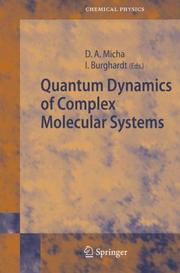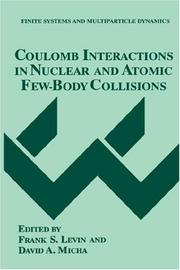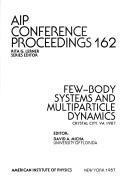| Listing 1 - 10 of 10 |
Sort by
|

ISBN: 1280701870 9786610701872 3540344608 3540344586 364243617X Year: 2007 Publisher: New York ; [Great Britain] : Springer,
Abstract | Keywords | Export | Availability | Bookmark
 Loading...
Loading...Choose an application
- Reference Manager
- EndNote
- RefWorks (Direct export to RefWorks)
Quantum phenomena are ubiquitous in complex molecular systems - as revealed by many experimental observations based upon ultrafast spectroscopic techniques - and yet remain a challenge for theoretical analysis. The present volume, based on a May 2005 workshop, examines and reviews the state-of-the-art in the development of new theoretical and computational methods to interpret the observed phenomena. Emphasis is on complex molecular processes involving surfaces, clusters, solute-solvent systems, materials, and biological systems. The research summarized in this book shows that much can be done to explain phenomena in systems excited by light or through atomic interactions. It demonstrates how to tackle the multidimensional dynamics arising from the atomic structure of a complex system, and addresses phenomena in condensed phases as well as phenomena at surfaces. The chapters on new methodological developments cover both phenomena in isolated systems, and phenomena which involve the statistical effects of an environment, such as fluctuations and dissipation. The methodology part explores new rigorous ways to formulate mixed quantum-classical dynamics in many dimensions, along with new ways to solve a many-atom Schroedinger equation, or the Liouville-von Neumann equation for the density operator, using trajectories and ideas related to hydrodynamics. Part I treats applications to complex molecular systems, and Part II covers new theoretical and computational methods.
Quantum theory. --- Molecular theory. --- Quantum dynamics --- Quantum mechanics --- Quantum physics --- Physics --- Mechanics --- Thermodynamics --- Chemistry, Physical and theoretical --- Matter --- Constitution --- Chemistry, Physical organic. --- Materials. --- Chemistry. --- Physical Chemistry. --- Atomic, Molecular, Optical and Plasma Physics. --- Materials Science, general. --- Theoretical and Computational Chemistry. --- Physical sciences --- Engineering --- Engineering materials --- Industrial materials --- Engineering design --- Manufacturing processes --- Chemistry, Physical organic --- Chemistry, Organic --- Materials --- Physical chemistry. --- Atoms. --- Physics. --- Materials science. --- Chemistry, Physical and theoretical. --- Chemistry, Theoretical --- Physical chemistry --- Theoretical chemistry --- Chemistry --- Material science --- Natural philosophy --- Philosophy, Natural --- Dynamics --- Stereochemistry
Book
ISBN: 9780470290743 0470290749 Year: 2020 Publisher: New York: Wiley,
Abstract | Keywords | Export | Availability | Bookmark
 Loading...
Loading...Choose an application
- Reference Manager
- EndNote
- RefWorks (Direct export to RefWorks)
Book
Year: 1965 Publisher: Uppsala University of Uppsala
Abstract | Keywords | Export | Availability | Bookmark
 Loading...
Loading...Choose an application
- Reference Manager
- EndNote
- RefWorks (Direct export to RefWorks)
Digital
ISBN: 9783540344605 Year: 2007 Publisher: Berlin, Heidelberg Springer-Verlag Berlin Heidelberg
Abstract | Keywords | Export | Availability | Bookmark
 Loading...
Loading...Choose an application
- Reference Manager
- EndNote
- RefWorks (Direct export to RefWorks)
Plasma physics --- Atomic physics --- Physicochemistry --- Chemistry --- Materials sciences --- Computer. Automation --- materiaalkennis --- plasmafysica --- chemie --- informatica --- fysicochemie

ISBN: 0306451492 Year: 1996 Publisher: New York, N.Y. Plenum Press
Abstract | Keywords | Export | Availability | Bookmark
 Loading...
Loading...Choose an application
- Reference Manager
- EndNote
- RefWorks (Direct export to RefWorks)

Abstract | Keywords | Export | Availability | Bookmark
 Loading...
Loading...Choose an application
- Reference Manager
- EndNote
- RefWorks (Direct export to RefWorks)
Book
ISBN: 3642260438 3642023053 9786612361777 1282361775 3642023061 Year: 2009 Publisher: Berlin ; Heidelberg : Springer-Verlag,
Abstract | Keywords | Export | Availability | Bookmark
 Loading...
Loading...Choose an application
- Reference Manager
- EndNote
- RefWorks (Direct export to RefWorks)
The role of quantum coherence in promoting the e ciency of the initial stages of photosynthesis is an open and intriguing question. Lee, Cheng, and Fleming, Science 316, 1462 (2007) The understanding and design of functional biomaterials is one of today’s grand challenge areas that has sparked an intense exchange between biology, materials sciences, electronics, and various other disciplines. Many new - velopments are underway in organic photovoltaics, molecular electronics, and biomimetic research involving, e. g. , arti cal light-harvesting systems inspired by photosynthesis, along with a host of other concepts and device applications. In fact, materials scientists may well be advised to take advantage of Nature’s 3. 8 billion year head-start in designing new materials for light-harvesting and electro-optical applications. Since many of these developments reach into the molecular domain, the - derstanding of nano-structured functional materials equally necessitates f- damental aspects of molecular physics, chemistry, and biology. The elementary energy and charge transfer processes bear much similarity to the molecular phenomena that have been revealed in unprecedented detail by ultrafast op- cal spectroscopies. Indeed, these spectroscopies, which were initially developed and applied for the study of small molecular species, have already evolved into an invaluable tool to monitor ultrafast dynamics in complex biological and materials systems. The molecular-level phenomena in question are often of intrinsically quantum mechanical character, and involve tunneling, non-Born- Oppenheimer e ects, and quantum-mechanical phase coherence.
Biomedical materials -- Congresses. --- Biomoleku ̈l. --- Charge transfer -- Congresses. --- Energy transfer -- Congresses. --- Nanostructured materials -- Congresses. --- Biomedical materials --- Nanostructured materials --- Energy transfer --- Charge transfer --- Energy Transfer --- Biocompatible Materials --- Physicochemical Processes --- Biophysical Processes --- Biochemical Processes --- Biomedical and Dental Materials --- Physicochemical Phenomena --- Chemicals and Drugs --- Chemical Processes --- Manufactured Materials --- Physical Processes --- Specialty Uses of Chemicals --- Biochemical Phenomena --- Biophysical Phenomena --- Chemical Phenomena --- Physical Phenomena --- Technology, Industry, and Agriculture --- Chemical Actions and Uses --- Phenomena and Processes --- Technology, Industry, Agriculture --- Physical & Theoretical Chemistry --- Biomedical Engineering --- Health & Biological Sciences --- Chemistry --- Physical Sciences & Mathematics --- Energy transfer. --- Biomedical materials. --- Biocompatible materials --- Biomaterials --- Medical materials --- Medicine --- Materials --- Chemistry. --- Physical chemistry. --- Chemistry, Physical and theoretical. --- Optical materials. --- Electronic materials. --- Biomaterials. --- Theoretical and Computational Chemistry. --- Optical and Electronic Materials. --- Optics, Lasers, Photonics, Optical Devices. --- Physical Chemistry. --- Biomedical engineering --- Biocompatibility --- Prosthesis --- Energy storage --- Force and energy --- Transport theory --- Chemistry, Physical organic. --- Optics --- Physical sciences --- Chemistry, Physical organic --- Chemistry, Organic --- Chemistry, Physical and theoretical --- Lasers. --- Photonics. --- Chemistry, Theoretical --- Physical chemistry --- Theoretical chemistry --- New optics --- Light amplification by stimulated emission of radiation --- Masers, Optical --- Optical masers --- Light amplifiers --- Light sources --- Optoelectronic devices --- Nonlinear optics --- Optical parametric oscillators --- Electronic materials --- Bioartificial materials --- Hemocompatible materials --- Biomaterials (Biomedical materials)

ISBN: 9783540344582 9783540344605 Year: 2007 Publisher: Berlin Heidelberg Springer Berlin Heidelberg
Abstract | Keywords | Export | Availability | Bookmark
 Loading...
Loading...Choose an application
- Reference Manager
- EndNote
- RefWorks (Direct export to RefWorks)
Quantum phenomena are ubiquitous in complex molecular systems - as revealed by many experimental observations based upon ultrafast spectroscopic techniques - and yet remain a challenge for theoretical analysis. The present volume, based on a May 2005 workshop, examines and reviews the state-of-the-art in the development of new theoretical and computational methods to interpret the observed phenomena. Emphasis is on complex molecular processes involving surfaces, clusters, solute-solvent systems, materials, and biological systems. The research summarized in this book shows that much can be done to explain phenomena in systems excited by light or through atomic interactions. It demonstrates how to tackle the multidimensional dynamics arising from the atomic structure of a complex system, and addresses phenomena in condensed phases as well as phenomena at surfaces. The chapters on new methodological developments cover both phenomena in isolated systems, and phenomena which involve the statistical effects of an environment, such as fluctuations and dissipation. The methodology part explores new rigorous ways to formulate mixed quantum-classical dynamics in many dimensions, along with new ways to solve a many-atom Schroedinger equation, or the Liouville-von Neumann equation for the density operator, using trajectories and ideas related to hydrodynamics. Part I treats applications to complex molecular systems, and Part II covers new theoretical and computational methods
Multi
ISBN: 9783642023064 Year: 2009 Publisher: Berlin, Heidelberg Springer-Verlag Berlin Heidelberg
Abstract | Keywords | Export | Availability | Bookmark
 Loading...
Loading...Choose an application
- Reference Manager
- EndNote
- RefWorks (Direct export to RefWorks)
The role of quantum coherence in promoting the e ciency of the initial stages of photosynthesis is an open and intriguing question. Lee, Cheng, and Fleming, Science 316, 1462 (2007) The understanding and design of functional biomaterials is one of today's grand challenge areas that has sparked an intense exchange between biology, materials sciences, electronics, and various other disciplines. Many new - velopments are underway in organic photovoltaics, molecular electronics, and biomimetic research involving, e. g. , arti cal light-harvesting systems inspired by photosynthesis, along with a host of other concepts and device applications. In fact, materials scientists may well be advised to take advantage of Nature's 3. 8 billion year head-start in designing new materials for light-harvesting and electro-optical applications. Since many of these developments reach into the molecular domain, the - derstanding of nano-structured functional materials equally necessitates f- damental aspects of molecular physics, chemistry, and biology. The elementary energy and charge transfer processes bear much similarity to the molecular phenomena that have been revealed in unprecedented detail by ultrafast op- cal spectroscopies. Indeed, these spectroscopies, which were initially developed and applied for the study of small molecular species, have already evolved into an invaluable tool to monitor ultrafast dynamics in complex biological and materials systems. The molecular-level phenomena in question are often of intrinsically quantum mechanical character, and involve tunneling, non-Born- Oppenheimer e ects, and quantum-mechanical phase coherence.
Optics. Quantum optics --- Electronics and optics of solids --- Physicochemistry --- Chemistry --- General biophysics --- Computer. Automation --- biologische materialen --- chemie --- informatica --- elektrodynamica --- transistoren --- halfgeleiders --- fysicochemie --- optica
Book
ISBN: 9783642023064 Year: 2009 Publisher: Berlin Heidelberg Springer Berlin Heidelberg
Abstract | Keywords | Export | Availability | Bookmark
 Loading...
Loading...Choose an application
- Reference Manager
- EndNote
- RefWorks (Direct export to RefWorks)
The role of quantum coherence in promoting the e ciency of the initial stages of photosynthesis is an open and intriguing question. Lee, Cheng, and Fleming, Science 316, 1462 (2007) The understanding and design of functional biomaterials is one of today's grand challenge areas that has sparked an intense exchange between biology, materials sciences, electronics, and various other disciplines. Many new - velopments are underway in organic photovoltaics, molecular electronics, and biomimetic research involving, e. g. , arti cal light-harvesting systems inspired by photosynthesis, along with a host of other concepts and device applications. In fact, materials scientists may well be advised to take advantage of Nature's 3. 8 billion year head-start in designing new materials for light-harvesting and electro-optical applications. Since many of these developments reach into the molecular domain, the - derstanding of nano-structured functional materials equally necessitates f- damental aspects of molecular physics, chemistry, and biology. The elementary energy and charge transfer processes bear much similarity to the molecular phenomena that have been revealed in unprecedented detail by ultrafast op- cal spectroscopies. Indeed, these spectroscopies, which were initially developed and applied for the study of small molecular species, have already evolved into an invaluable tool to monitor ultrafast dynamics in complex biological and materials systems. The molecular-level phenomena in question are often of intrinsically quantum mechanical character, and involve tunneling, non-Born- Oppenheimer e ects, and quantum-mechanical phase coherence.
Optics. Quantum optics --- Electronics and optics of solids --- Physicochemistry --- Chemistry --- General biophysics --- Computer. Automation --- biologische materialen --- chemie --- informatica --- elektrodynamica --- transistoren --- halfgeleiders --- fysicochemie --- optica
| Listing 1 - 10 of 10 |
Sort by
|

 Search
Search Feedback
Feedback About UniCat
About UniCat  Help
Help News
News